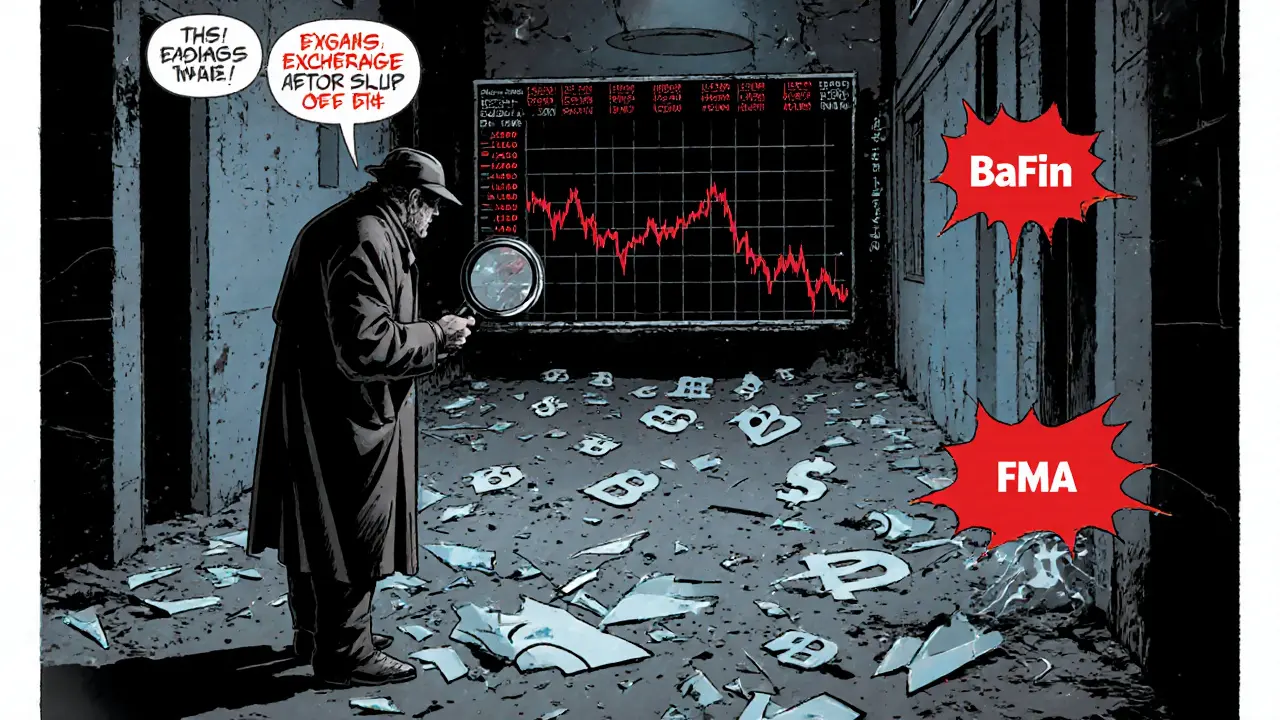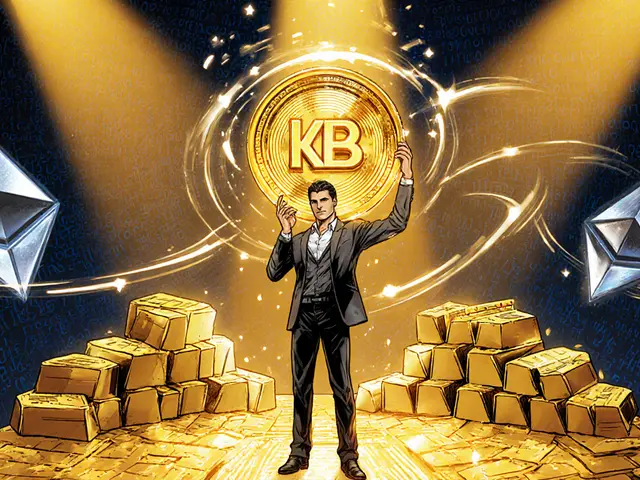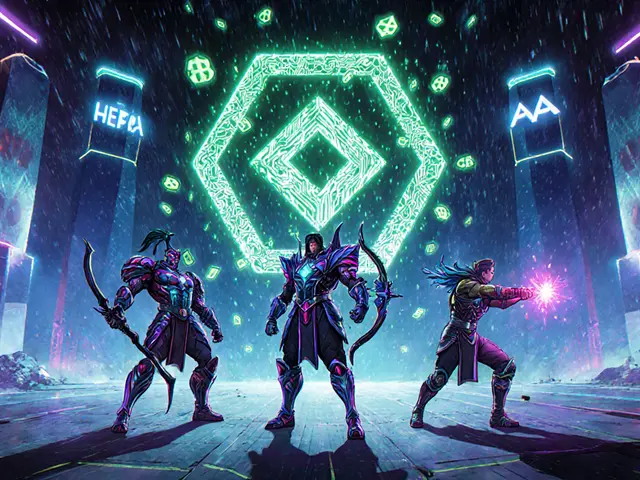- Home
- Cryptocurrency
- Karatgold Coin (KBC) Explained: Gold‑Backed Crypto Basics

Karatgold Coin (KBC) Explained: Gold‑Backed Crypto Basics
KBC Token Value Calculator
Current Price: $0.0011
All-Time High: $0.1261
All-Time Low: $0.0001425
Market Cap: $13-14 million
Total Supply: 12 billion KBC
Circulating Supply: 0 (reported)
Daily Volume: $0 (practically none)
Holders: ~21,270 (unverified)
Estimated Value:
This calculator shows how much your KBC holdings would be worth at different historical price points.
Important: KBC has extremely low liquidity and regulatory concerns. The token's value has dropped over 99% since its ICO. Consider this primarily as an educational tool.
When you hear the name Karatgold Coin (KBC) a gold‑backed ERC‑20 token on the Ethereum blockchain, you probably wonder whether it’s a real way to own digital gold or just another hype project. In plain terms, KBC tries to let you move a slice of physical gold around as if it were a regular crypto coin. The idea sounds neat, but the reality is riddled with missing liquidity, regulatory warnings, and a price that has cratered more than 99% since its 2018 ICO.
Key Takeaways
- KBC is an ERC‑20 token launched in 2018 by Karatbars International and claims to be backed by physical gold.
- It trades on a handful of obscure exchanges at around $0.001, far below its $0.05 ICO price.
- Major regulators in Germany (BaFin) and New Zealand have issued warnings about the project.
- Liquidity is essentially zero - daily volume is $0 on most platforms.
- Compared to established gold‑backed tokens like Paxos Gold (PAXG) and Tether Gold (XAUT), KBC falls short on transparency, compliance, and market activity.
What Is Karatgold Coin?
Karatgold Coin (KBC) was announced in February 2018 by Karatbars International, a German‑based company that sold small‑denomination gold bars and certificates. The coin’s whitepaper promised a “digital gold standard” where each token represents a fractional claim on the company’s CashGold reserves - physically stored gold that investors could, in theory, redeem.
The project raised about $100million in an Initial Coin Offering (ICO) that lasted from March22to April212018. The ICO price was roughly $0.05 per KBC token, which set a high bar for later market expectations.
How Does KBC Work Technically?
At its core, KBC is a standard ERC‑20 token built on Ethereum. Its smart‑contract address is 0xf3586684107CE0859c44aa2b2E0fB8cd8731a15a. Being ERC‑20 means you can store KBC in any Ethereum‑compatible wallet - MetaMask, Trust Wallet, hardware wallets, etc.
The “gold‑backed” claim relies on Karatbars’ internal ledger that supposedly locks an equivalent amount of CashGold for every token issued. In practice, there is no publicly audited reserve, and the token’s contract does not enforce a 1‑to‑1 gold redemption mechanism.
Because KBC lives on Ethereum, transaction fees (gas) are paid in ETH, not in gold. This also means KBC inherits all of Ethereum’s scalability and security properties, but shares its volatility in gas prices.
Current Market Snapshot (October2025)
| Metric | Value |
|---|---|
| Current price | $0.0011 (approx.) |
| All‑time high | $0.1261 (July2019) |
| All‑time low | $0.0001425 (Dec2022) |
| Market cap | $13‑14million |
| Total supply | 12billion KBC |
| Circulating supply | 0 (reported by major trackers) |
| Daily volume | $0 (practically none) |
| Number of holders (on‑chain) | ~21,270 (unverified) |
The numbers tell a stark story: price down >99% from the ICO, negligible trading activity, and a “circulating supply” that most data aggregators list as zero - a red flag for anyone thinking about buying or holding KBC.

Regulatory Landscape and Red Flags
Two regulators have publicly warned about entities linked to KBC:
- German Federal Financial Supervisory Authority (BaFin) issued statements questioning the legality of Karatbars’ financial products, including the gold‑backed token model.
- New Zealand Financial Markets Authority (FMA) similarly flagged the project’s promotional material as potentially misleading for retail investors.
Neither BaFin nor the FMA have granted KBC any licensing or registration, which means the token operates in a regulatory gray zone. For investors, that translates to higher legal risk - especially if the project ever faces enforcement actions.
How (and Whether) You Can Acquire KBC
Because liquidity is almost non‑existent, buying KBC is a hassle. A few obscure exchanges still list the pair, but order books are empty and spreads are astronomical. The typical steps would be:
- Set up an Ethereum‑compatible wallet (MetaMask, Ledger, etc.).
- Purchase ETH on a major exchange (Coinbase, Kraken, etc.).
- Transfer ETH to the exchange that lists KBC.
- Place a limit order at the current market price (~$0.001) - you’ll likely wait days or never fill.
- If you manage to acquire KBC, store it in your personal wallet; the token does not have a dedicated “Karatgold Wallet” released to the public.
Given the effort and the near‑zero chance of reselling, most experienced traders avoid KBC altogether.
Comparison with Other Gold‑Backed Tokens
| Feature | Karatgold Coin (KBC) | Paxos Gold (PAXG) | Tether Gold (XAUT) |
|---|---|---|---|
| Blockchain | Ethereum (ERC‑20) | Ethereum (ERC‑20) | Ethereum (ERC‑20) |
| Gold backing method | Company‑claimed CashGold (no public audit) | Physical gold held in London vaults, audited monthly | Physical gold in Swiss vaults, audited quarterly |
| Regulatory status | Unlicensed, regulatory warnings | Licensed by NYDFS, complies with AML/KYC | Licensed in several jurisdictions, complies with AML/KYC |
| Market cap (2025) | $13‑14M | $1.1B | $800M |
| Daily trading volume | ~$0 | $80M+ | $35M+ |
| Price correlation to gold | Very weak | Near‑parity (1PAXG ≈ 1oz gold) | Near‑parity (1XAUT ≈ 1oz gold) |
| Community & support | Minimal, inactive since 2020 | Active, regular updates | Active, regular updates |
The table makes it clear: KBC lacks the transparency, liquidity, and regulatory compliance that give PAXG and XAUT real utility as digital gold.
Pros, Cons, and Bottom‑Line Assessment
Pros
- Conceptually simple - a token tied to physical gold.
- Runs on Ethereum, so any ERC‑20 wallet can hold it.
- Low entry price (under a cent) for speculative traders.
Cons
- Zero liquidity - you can hardly buy or sell.
- Regulatory warnings from BaFin and New Zealand FMA.
- No audited gold reserve; gold backing is not verifiable.
- Stalled development - promised wallets, exchange, and mobile apps never materialized.
- Price has collapsed >99% since the ICO.
Bottom line: unless you’re collecting obscure tokens for a curiosity‑driven portfolio, KBC offers little practical value. For anyone looking to hold digital gold, established tokens like PAXG or XAUT are far safer choices.
Frequently Asked Questions
What does each KBC token represent?
The project claims each token corresponds to a fractional share of Karatbars’ CashGold reserves, but no independent audit confirms the amount of gold actually set aside.
Can I redeem KBC for physical gold?
There is no public redemption process. The whitepaper mentions a future redemption service, but it has never been launched.
Why is the circulating supply shown as zero?
Major tracking sites list zero circulating supply because the token’s smart contract never transferred any tokens to public wallets after the ICO, suggesting the tokens remain locked or centrally controlled.
Is KBC legal to own in New Zealand?
The New Zealand Financial Markets Authority has issued warnings that KBC‑related promotions may be misleading. While ownership isn’t outright illegal, investors face higher regulatory risk.
How does KBC compare to Paxos Gold?
PAXG is fully audited, has strong regulatory clearance, and trades with high volume. KBC lacks audits, faces regulatory warnings, and has near‑zero liquidity, making PAXG a far more reliable digital gold option.
In short, Karatgold Coin is a cautionary tale of ambitious marketing meeting a harsh market reality. If you’re serious about holding gold in crypto form, look for tokens with transparent reserves, active trading, and clear regulatory approval.
Cormac Riverton
I'm a blockchain analyst and private investor specializing in cryptocurrencies and equity markets. I research tokenomics, on-chain data, and market microstructure, and advise startups on exchange listings. I also write practical explainers and strategy notes for retail traders and fund teams. My work blends quantitative analysis with clear storytelling to make complex systems understandable.
Popular Articles
11 Comments
Write a comment Cancel reply
About
DEX Maniac is your hub for blockchain knowledge, cryptocurrencies, and global markets. Explore guides on crypto coins, DeFi, and decentralized exchanges with clear, actionable insights. Compare crypto exchanges, track airdrop opportunities, and follow timely market analysis across crypto and stocks. Stay informed with curated news, tools, and insights for smarter decisions.






KBC looks like a classic case of hype over substance. If you're curious, treat it as a learning exercise, not a serious investment.
Listen up, folks, you can't seriously expect a token with zero liquidity to outperform gold, so steer clear, stay safe, and keep your money where it actually works, not in some obscure smart‑contract experiment. The market will punish naïve believers, and regulators are already flashing warnings, so act wisely.
When evaluating Karatgold Coin, the first red flag is the complete absence of genuine trading activity, which makes any price discovery purely speculative. The token’s claim of being gold‑backed is undermined by the total opacity surrounding the CashGold reserves; there is no third‑party audit to verify the existence of the physical metal. Moreover, the circulating supply is reported as zero by major analytics platforms, suggesting that the token is effectively locked away and unavailable to the public. Even the ICO price of $0.05 is a relic of a time when investors were dazzled by the promise of digital gold, yet the current market price hovers around a thousandth of a cent. This represents a loss of more than 99% of the original investment, a slide that would be considered catastrophic in any conventional asset class. Liquidity is effectively non‑existent; daily volume registers as $0 on virtually all exchanges, meaning you cannot sell without creating a price impact that would evaporate the remainder of your holdings. Regulatory bodies have issued formal warnings – Germany’s BaFin questions the legality of Karatbars’ products, and New Zealand’s FMA has labeled the promotional material as potentially misleading. Those warnings are not merely perfunctory; they signal that the token operates in a gray area that could invite enforcement actions at any moment. The smart contract itself is a standard ERC‑20 with no built‑in redemption mechanism, leaving the gold‑backing claim as a purely marketing narrative. In contrast, established gold‑backed tokens such as PAXG and XAUT provide audited vaults, clear redemption pathways, and robust compliance frameworks. The lack of such infrastructure for KBC renders it a speculative curiosity rather than a viable store of value. Former holders who attempted to liquidate their positions reported massive slippage or outright failure to find a counter‑party. Community sentiment on forums is overwhelmingly negative, with many participants describing the project as a classic pump‑and‑dump scheme. The promised “Karatgold Wallet” never materialized, further eroding trust in the project's roadmap. Even the team’s communication has dwindled, with the last significant update dating back to 2020. In short, the token fails every fundamental test of credibility, liquidity, transparency, and regulatory compliance, making it a risky gamble for anyone seeking a serious exposure to gold via crypto.
Your optimism is a joke.
It is imperative to recognize that the ostensible “gold‑backed” nature of the token remains empirically unsubstantiated, thereby rendering any assertion of intrinsic value fundamentally untenable. Moreover, the conspicuous absence of audited reserves constitutes a breach of fiduciary transparency, which, when juxtaposed with regulatory admonitions from BaFin and the New Zealand Financial Markets Authority, amplifies the peril inherent in custodial reliance. One must also contemplate the systemic risk engendered by the token’s negligible market depth, which precludes orderly liquidation and invites price manipulation. Consequently, prudential investors are advised to eschew participation in such opaque undertakings and to allocate capital toward instruments possessing verifiable asset backing and regulatory sanction.
So KBC is basically a glittery meme coin, huh? I guess the next step is a blockchain‑based paperclip-anyone else see the irony?
Hey, thanks for the heads‑up! Keeping an eye on liquidity is definitely the smart move, and there are plenty of better‑backed tokens out there to explore.
From a technical standpoint, the ERC‑20 footprint without audited collateral yields a negligible utility index.
Seems like the token’s on‑chain metrics just echo the same low‑utility signal.
For anyone considering digital gold, it's worth noting that PAXG and XAUT both publish monthly audit reports, maintain robust KYC/AML procedures, and trade with daily volumes in the tens of millions-features KBC simply lacks.
The mainstream narrative conveniently highlights those “audited” tokens, yet the very institutions that certify them are intertwined with central banks, raising the question of hidden control over what we perceive as decentralized gold.